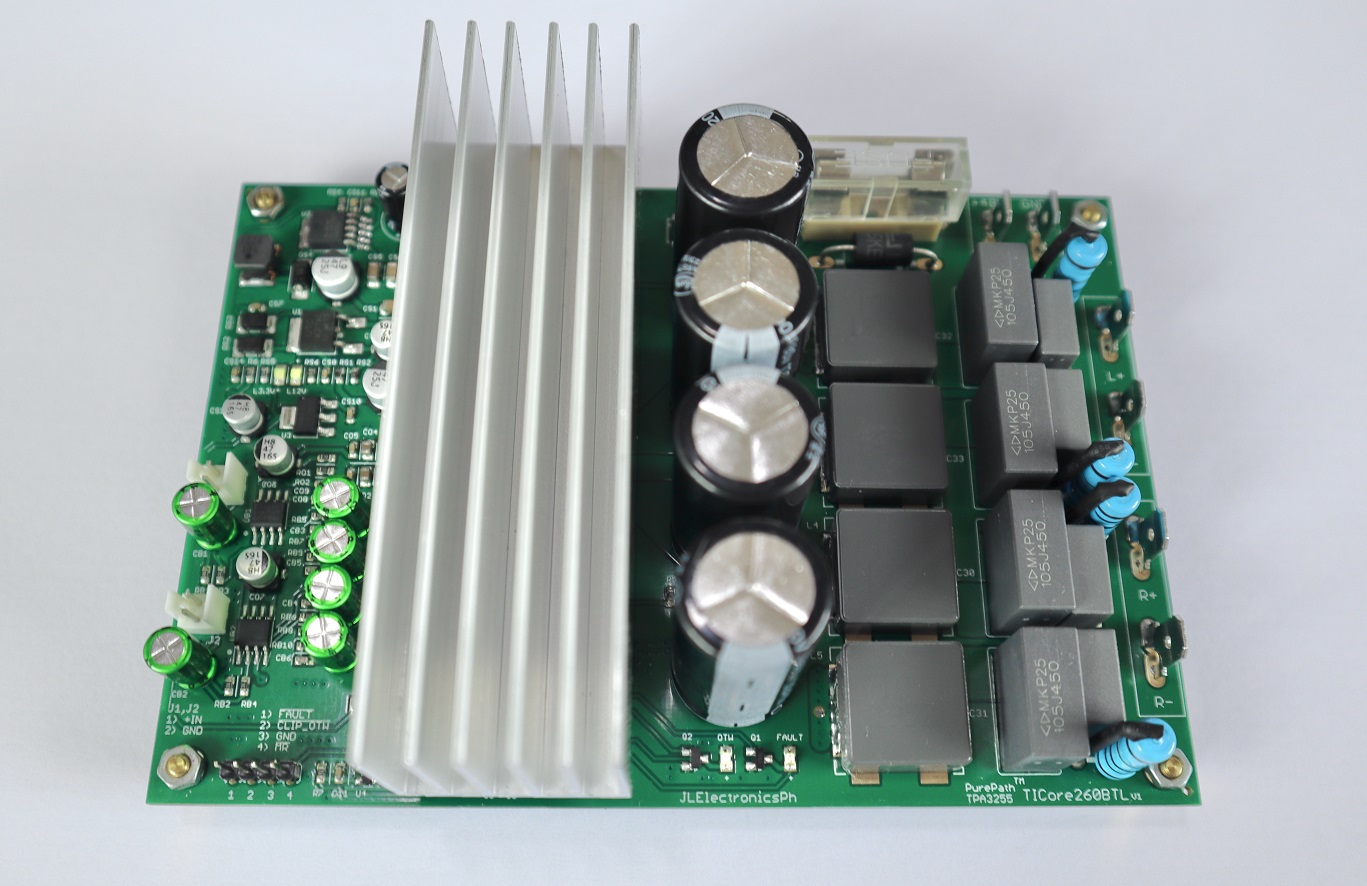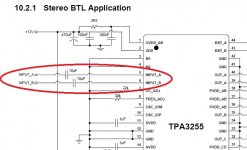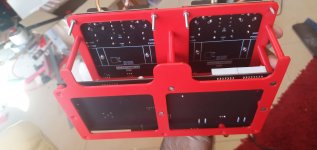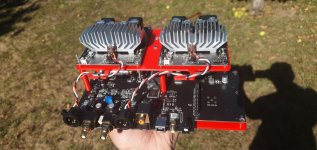I gues it's your brain that has burned in 😉. You just got accustomed to your new or newly modified gear.I don't know if it's psychological, but something I have always laugh about, the electronic burn in, seems to really happen.
Besides of electro-mechanical transducers and besides of deteriorating over some (long) time I don't see any reason why devices consisting of solid and stable components should alter their properties.
Best regards!
I do agree at 100%, I have always laugh at the cable burn in or other things like that 🙂
But it's true, I had zero bass, had to set the bass to the maximum, and the treble to the minimum, and now it's all at zero... and works great.
But it's true, I had zero bass, had to set the bass to the maximum, and the treble to the minimum, and now it's all at zero... and works great.
I use a Beaglebone Black, which is a small computer similar to the rPi, and yes, this requires a certain amount of manual configuration from the command line.@ Linuxfan :
Are you familiar with all the RPi things?
...
it looks to not be very simple to have it working properly
For the rPi I've read that setup is reasonably straightforward with Moode and Volumio, possibly because these both include a browser-based configuration menu.
moodeaudio.org
Volumio - The Audiophile Music Player
Moode setup guide
moode/setup.txt at master * moode-player/moode * GitHub
Moode forum
Moode Forum
The 3rd XLR cable is ground, not neutral. It connects to a GND connection on the amp board - where your black wire is presently connected would be fine.
XLR pin 2 = +ve
XLR pin 3 = -ve
XLR pin 1 = AGND
Hi, I have solder a soic to dip8 adapter, and 4 elna caps. -> nothing is working now so going to try the bypass to get rid of the op amp input of the 3e audio board.
Will let you know.
Attachments
I use a Beaglebone Black, which is a small computer similar to the rPi, and yes, this requires a certain amount of manual configuration from the command line.
For the rPi I've read that setup is reasonably straightforward with Moode and Volumio, possibly because these both include a browser-based configuration menu.
moodeaudio.org
Volumio - The Audiophile Music Player
Moode setup guide
moode/setup.txt at master * moode-player/moode * GitHub
Moode forum
Moode Forum
Moode looks nice
thank you
Some news,
THANK YOU A LOT LINUXFAN !!!
I made the input bypass as you told me, what a difference !!!!
A completly different sound, more dynamic, and a huge bass improvment ! It's completely different, like other speakers, I mean, it's not a small or placebo difference, before I had no bass and now almost too much !
So I'm really happy 🙂
Just a technical question, after the blocking caps there is smd resistor (100Ohms i think) and a smd caps (100pF I think) but there is nothing advised by TI in the TPA3255 datasheet.
Can somebody explain me?
Also, I can reach the maximum level of my DAC very easily. I have a good volume but I thought those PBTL amplifiers would be able to kill my speakers eaysily, which it's not the case.
Any idea about the max power PBTL on 6-8 Ohms speakers?
Output filter 10uH and 1uF
Thanks
THANK YOU A LOT LINUXFAN !!!
I made the input bypass as you told me, what a difference !!!!
A completly different sound, more dynamic, and a huge bass improvment ! It's completely different, like other speakers, I mean, it's not a small or placebo difference, before I had no bass and now almost too much !
So I'm really happy 🙂
Just a technical question, after the blocking caps there is smd resistor (100Ohms i think) and a smd caps (100pF I think) but there is nothing advised by TI in the TPA3255 datasheet.
Can somebody explain me?
Also, I can reach the maximum level of my DAC very easily. I have a good volume but I thought those PBTL amplifiers would be able to kill my speakers eaysily, which it's not the case.
Any idea about the max power PBTL on 6-8 Ohms speakers?
Output filter 10uH and 1uF
Thanks
Attachments
Last edited:
Yes, I'm surprised that only a few other people have bothered to go this way.I made the input bypass as you told me, what a difference !!!!
Of course it's not for everyone - you need a differential source, preferably with solid line drive capability - because there is no longer a buffer stage at the amp's inputs. DAC's with opamp-based output stages generally meet this description.
Have a look at the TPA3255EVM schematic -after the blocking caps there is smd resistor (100Ohms i think) and a smd caps (100pF I think) but there is nothing advised by TI in the TPA3255 datasheet.
https://www.ti.com/lit/pdf/slou441
at the input of the TPA3255 is a series resistor (R5) and a cap to GND (C19). I think these are to filter high frequency noise. More knowledgeable people here might be able to comment further.
I would leave them be.
Some news,
THANK YOU A LOT LINUXFAN !!!
I made the input bypass as you told me, what a difference !!!!
A completly different sound, more dynamic, and a huge bass improvment ! It's completely different, like other speakers, I mean, it's not a small or placebo difference, before I had no bass and now almost too much !
So I'm really happy 🙂
Just a technical question, after the blocking caps there is smd resistor (100Ohms i think) and a smd caps (100pF I think) but there is nothing advised by TI in the TPA3255 datasheet.
Can somebody explain me?
Also, I can reach the maximum level of my DAC very easily. I have a good volume but I thought those PBTL amplifiers would be able to kill my speakers eaysily, which it's not the case.
Any idea about the max power PBTL on 6-8 Ohms speakers?
Output filter 10uH and 1uF
Thanks
+1
Enjoy...
😉
Yes, I'm surprised that only a few other people have bothered to go this way.
Of course it's not for everyone - you need a differential source, preferably with solid line drive capability - because there is no longer a buffer stage at the amp's inputs. DAC's with opamp-based output stages generally meet this description.
Have a look at the TPA3255EVM schematic -
https://www.ti.com/lit/pdf/slou441
at the input of the TPA3255 is a series resistor (R5) and a cap to GND (C19). I think these are to filter high frequency noise. More knowledgeable people here might be able to comment further.
I would leave them be.
Some news of the project ����
Souding really well now I'm super happy.
First assembly on the 3d printed chassis. I have to buy the good screws ��
Question, if I buy 2 btl boards, is it possible to supply them with 1 xlr cable - > my dac is stereo, and would like 2 btl amplifier boards, to bi amp each speakers. Don't know if I'm clear ��
Sorry for my voice on the video ��
Attachments
Last edited:
Is that normal, that my mono TPA3255 clip led goes on with the bass frequenzy.
For me it does not play very loud. Power supply draw is about 80W for the hole amp TPA3255 Stereo TPA3255 mono and DSP. Could it be because today I have only the stock 3e programm für stereo speaker with high and low separation?!?!?
Thanks
Ps I am waiting for my programming board to change parameter of DSP
For me it does not play very loud. Power supply draw is about 80W for the hole amp TPA3255 Stereo TPA3255 mono and DSP. Could it be because today I have only the stock 3e programm für stereo speaker with high and low separation?!?!?
Thanks
Ps I am waiting for my programming board to change parameter of DSP
Hi guys, I hope to be able to source your combined intelligence on my noob problem.
I'm building a 3-way active speaker. I'd like to power each driver with an individual TPA3255 channel.
So the options I see:
- buy one 2-channel TPA3255 board for the mid and high driver, and a 1-channel board for the subwoofer driver...
or
- buy a 4-channel TPA3255 board to power 3 drivers and leave one channel unused.
(I'm looking at this 4 channel board for example : Amplifier Board - AIYIMA B2D2205 - TPA3255 | 4 Channel 315W Power Ampl )
Is that second option okay to do though?
Is it okay to leave one channel unused / unconnected?
I think I remember reading that TPA's don't deal well with unconnected outputs - would using only 3 channels of that 4 channel amp create problems?
Hope you can help me out with this.
I'm building a 3-way active speaker. I'd like to power each driver with an individual TPA3255 channel.
So the options I see:
- buy one 2-channel TPA3255 board for the mid and high driver, and a 1-channel board for the subwoofer driver...
or
- buy a 4-channel TPA3255 board to power 3 drivers and leave one channel unused.
(I'm looking at this 4 channel board for example : Amplifier Board - AIYIMA B2D2205 - TPA3255 | 4 Channel 315W Power Ampl )
Is that second option okay to do though?
Is it okay to leave one channel unused / unconnected?
I think I remember reading that TPA's don't deal well with unconnected outputs - would using only 3 channels of that 4 channel amp create problems?
Hope you can help me out with this.
TPA3255 for mid and high looks like overkill to me. So I would propose one mono PBTL for the woofer and 2ch TPA3116 for mid and high.
It might be overkill indeed.
My idea is/was though to use the same parts everywhere to keep everything as matched as possible.
It's a long term hobby project so saving a few bucks here or there isn't really the issue - I just want to get it done with the least trouble 🙂
(Preferably no gain difference between drivers if that makes sense)
Spending 90 bucks on that 4 channel amp is perfectly fine and would suit my "keep everything matched" need perfectly, but I'm not sure whether it's okay to use that board with 3 connected channels only.
My idea is/was though to use the same parts everywhere to keep everything as matched as possible.
It's a long term hobby project so saving a few bucks here or there isn't really the issue - I just want to get it done with the least trouble 🙂
(Preferably no gain difference between drivers if that makes sense)
Spending 90 bucks on that 4 channel amp is perfectly fine and would suit my "keep everything matched" need perfectly, but I'm not sure whether it's okay to use that board with 3 connected channels only.
Last edited:
TPA3255 for mid and high looks like overkill to me. So I would propose one mono PBTL for the woofer and 2ch TPA3116 for mid and high.
TPA3255EVM in 2.1 configuration.
Best regards!
TPA3255EVM in 2.1 configuration.
Best regards!
the TPA3255EVM board at the price I can find it (around 168 euros?) is a bit out of my budget I'm afraid..
Any suggestions for a decent *finished* TPA32XX board that costs a bit less than the EVM board?
Alternative to 3E Audio and made in South America )
jlelectronicsph on eBay
✅ Transient voltage protection (SCR + TVS + Fuse)
✅ Oversized Zobel Network
✅ Linear post regulator
✅ Voltage supervisor (no startup/shutdown pops)
✅ Nichicon muse input caps
✅ OPA1656

jlelectronicsph on eBay
✅ Transient voltage protection (SCR + TVS + Fuse)
✅ Oversized Zobel Network
✅ Linear post regulator
✅ Voltage supervisor (no startup/shutdown pops)
✅ Nichicon muse input caps
✅ OPA1656
Last edited:
One option is the newer 3e-audio-TPA3255 2ch 260W board that’s has the replaceable op-amps. I just got it yesterday and I’m playing it stock (5532 op amps) right now using only the 36V SMPS supplies by 3e. I’ll test it with the 48V version later as well as roll thru some different op-amps now that they can be easily changed. It is presenting with an open, airy soundstage. The very bottom is light but that may be due to the PS but it is pleasing non-the-less. Unless I had a bad experience with the same 3e version I bought before this one (sounded dull and lifeless compared to my regular LM3886 amp) this a great little amp now. 3e’s all-in-one integrated amp might be an interesting thought to try as well. It may or may not be the best sounding one but it’s relatively inexpensive. I have not listened to any other Class D amps but 3e’s to be honest.
Cheers,
Pete
Cheers,
Pete
- Home
- Amplifiers
- Class D
- What is wrong with TPA3255?



